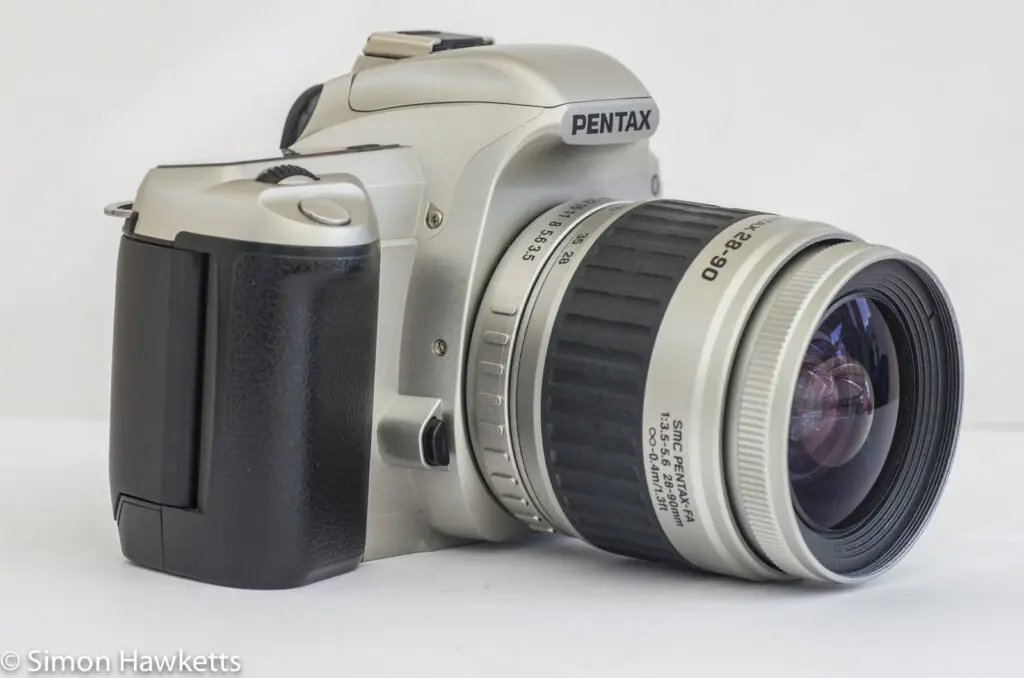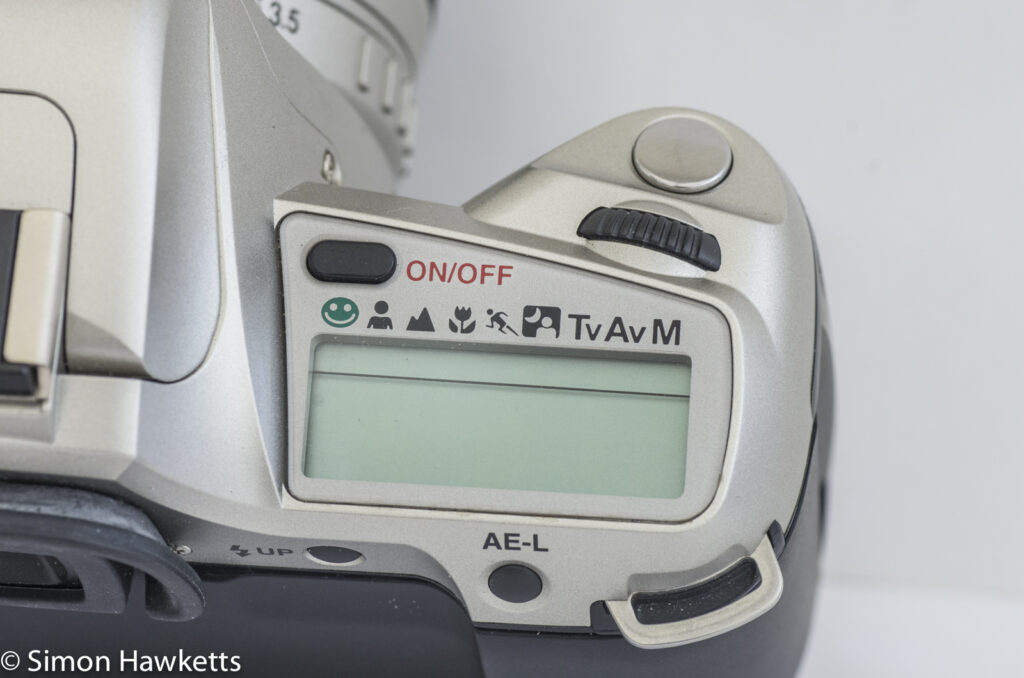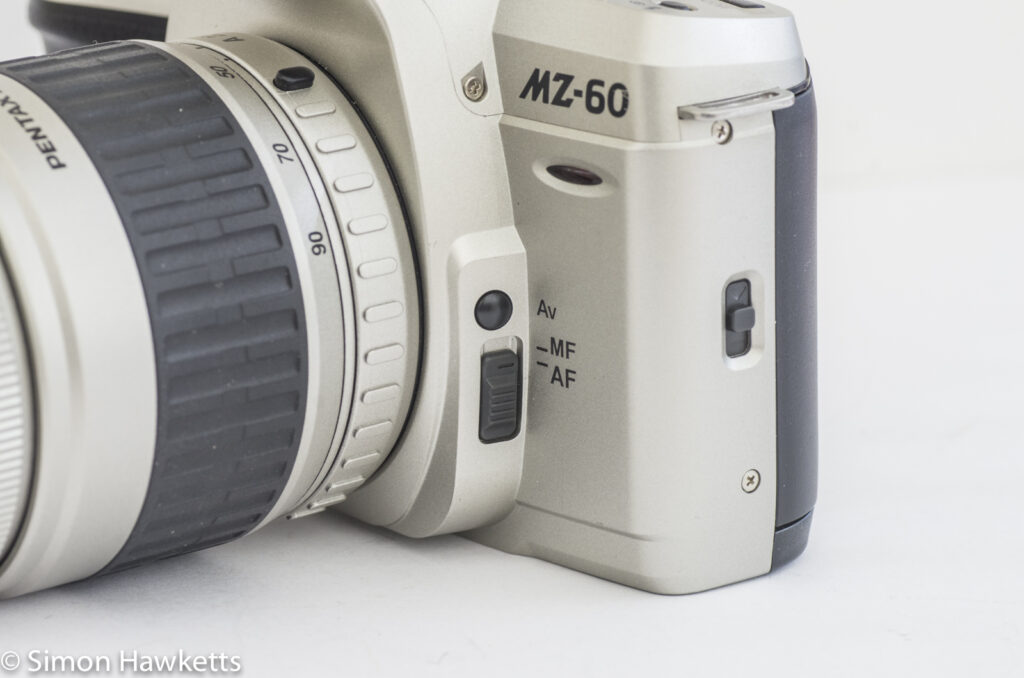Pentax MZ-60 QD 35 mm autofocus SLR
The Pentax MZ-60 was the last 35 mm camera Pentax produced in the MZ series, and in fact the penultimate 35 mm film camera they ever produced – only the *ist followed it. It is similar to other cameras in the series, being lightweight plastic construction and quite small and follows the route started with the MZ-50, 30 & 7 models by having several picture modes along with standard Aperture, Shutter, Program mode and manual operation.
Pentax MZ-60 Images











I bought the camera from eBay for £13 which included the body and the 28 – 90 mm zoom along with the printed handbook, the original Pentax strap and a nice padded and zipped camera case. As with all the MZ series in my collection, it’s in almost new condition – I can’t actually find a mark on it.
Pentax MZ-60 description
There are several differences in the styling of this camera compared to the other units in the MZ series.
Although it has the basic functionality of the MZ-50 and 30 models, it no longer sports the mode dial on the top left-hand side of the camera or the two-way rocker lever under the shutter release of those models. Instead, there is a control panel on the top left with individual buttons for the mode, flash and drive controls along with a button to control the date function.
The two-way rocker has been replaced with a similar control which is behind the shutter button. I think the movement of the rocker control is an improvement – the control seems easier to move with the camera to the eye, although it would have been better still if it had been changed to a control wheel rather than a rocker switch. The other change which removed the mode dial is to my mind a step backwards. It’s much more fiddly to change modes by holding the tiny mode button and using the rocker switch to do the change.
An indicator to the entry level status of the MZ-60 is the plastic ‘crippled’ KAF mount, which means it will only work properly with the F & FA lenses. This is the same as the MZ-30
Date imprint
As I stated above, this camera has a date imprint function fitted into the body of the camera, which allows the date and time the picture was taken to be imprinted on the negative. On earlier cameras in the MZ series this functionality was provided by an optional data back, but for the MZ-60 QD it was moved into the camera itself. By pressing the date function button and moving the rocker switch, the format of the date to be imprinted could be changed to include the time, the date and alter the format of the date. Finally, there was an option to set it to ——— which basically turned the option off.
I’m not sure how much I would use this feature – it’s nice to know exactly when the picture was taken, but having it permanently marked on the negative seems a bit destructive to me. The MZ-S has a much more useful option of printing the picture metadata (like aperture, shutter speed etc) on the film edge next to each picture – mind you, the MZ-S was the top model in the range and the MZ-60 about the bottom!
Exposure modes
There are a wealth of different exposure modes available on the MZ-60, as with most of the cameras in the range.
Along with the ‘Green’ fully automatic mode, there are several scene modes where the photographer chooses a scene similar to the picture he/she is taking, and the camera is set up appropriately for that scene. For example, if ‘landscape’ mode were chosen, the camera would make sure the aperture was kept stopped down to increase the depth of field etc. These modes are useful for beginner photographers, and I guess are a good thing to add to cameras, since it allows the camera to ‘grow’ with you.
Once you have moved beyond the fully automatic and scene modes, the camera is still there for you to use in aperture priority or shutter priority mode, etc. It also makes the camera more useful for different members of the family to use, with different skill levels.
As I said above, along with the scene modes, the camera features Tv, Av and M modes which are shutter speed priority, aperture priority and Manual mode. In these modes, the rocker lever behind the shutter button moves the shutter or aperture for Tv and Av and will alter both in Manual mode when used in conjunction with a small button on the side of the lens mount. On the back of the camera is an exposure lock button which allows the photographer to meter for one part of the scene, lock the exposure and then recompose and shoot.
Viewfinder
The viewfinder is the part that really lets the camera down and would make it very difficult to use in anything other than the auto and scene modes. Although the image itself is large enough, the additional exposure information which is expected in this type of camera is non-existent.
The only information shown in the viewfinder is a green focus symbol when focus is achieved, a flash symbol for when the flash is needed, and a green circle to show that the exposure is OK. If the exposure is off, a red + above or – below the circle will show. If the green circle and the + or – show the exposure is off by 1 stop, if just the + or – show the exposure is more than one stop out. Although this is adequate for getting the exposure right, it doesn’t give you any creative information about the exposure.
Drive Modes
The drive modes offered by the Pentax MZ-60 are controlled by the ‘drive’ button on the top plate control panel. By pressing and holding the button and moving the rocker switch, the camera switches between the various drive modes, which are displayed on the top plate LCD. The modes are
- Single frame mode
- Multiple frame mode
- Self timer mode (shutter fires after 12 seconds)
- 2 sec mirror lock up (the mirror is flipped up and 2 seconds later the shutter is fired)
- Auto bracket mode of 1/2 stop
- Auto bracket mode of 1 stop
Some of these are pretty sophisticated modes – the 2-second mirror lock up for example is something that a snapshot user would probably have no use for and wouldn’t know why it was included. I guess this camera is just in the era when these features are basically software, so once they have been written for one model, it’s almost zero cost to add it to another one.
Standard supplied Lens
The lens supplied with the Pentax MZ-60 is a plastic construction slow zoom lens which, at the time the camera was made, was becoming the standard lens fitted to SLR cameras – a trend which continues to this day.
Earlier models in the series had a 35 – 80 mm, and then later this was replaced with a 28 – 80 mm. By the time the MZ-60 was made, the telephoto end had been extended to become 28 – 90 mm, which is the one fitted to my camera.
As standard lenses go it’s about what you would expect – quite a slow maximum aperture and being focus by a screw thread driven by the camera quite noisy, although surprisingly fast to focus, and quite good at achieving focus in low light. The click-stop, 6 blade aperture goes from f/3.5 to f/22 and has an A position allowing the camera to control the f-stop setting from the rocker control.
Conclusion
All in all, this camera is a bit of an oddity. There are a wealth of exposure modes and drive modes which make it a well featured camera, but the viewfinder and lens mount make it much less useful than those features would suggest. I suspect that it was produced at a time when Pentax were really feeling the pinch from other manufacturers like Canon and Nikon and were trying to produce a cheaper camera for the mass market but with appeal to the serious amateur as well.
Pentax MZ-60 Specifications
- Pentax MZ-60 35mm SLR autofocus camera
- Scene modes and green mode exposure control
- Aperture priority, Shutter priority and Manual exposure control
- DX coded auto film speed selection with manual override
- 30sec to 1/2000sec shutter on auto & manual selection
- Crippled KAF plastic lens mount
- TTL autofocus system range 0 to 18EV
- Penta mirror viewfinder with limited information display
- Top plate LCD panel display
- Self timer with 12sec delay and 2sec mirror lockup
- 1/2 & 1 stop bracketing
- Single shot or auto wind at 1 frame/sec
- 2 segment metering
- AE Lock button
- Powered by 2 CR2 batteries
- Date imprint function
- 28 – 90mm f/3.5-f/5.6 plastic zoom lens
- Manual available on-line here
- Body Ser No: 5519578
- Lens Ser No: 6569218
Discover more from Everything Vintage
Subscribe to get the latest posts sent to your email.








